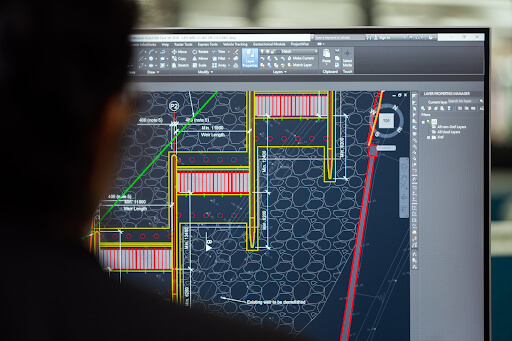 1-800-805-5783
1-800-805-5783 
Domain-Driven Design (DDD) marks a significant shift in the approach to software development, emphasizing a deep understanding and modeling of the business domain. This strategy is designed to improve software quality by aligning it closely with the specific business needs it addresses.
Domain-driven design (DDD) is a philosophy in software development that centers on the ‘domain’ or the specific business context in which the software operates. It promotes a ‘ubiquitous language,’ a shared lexicon between software developers and business stakeholders. It is employed in both the design and implementation phases to ensure the software precisely mirrors its intended business domain.
Also read: Software Architecture: Understanding Styles and Patterns for Effective System Design.
DDD’s efficacy stems from its foundational principles that guide developers in crafting software that accurately represents the complexities of the business it is designed for.
At the core of any business is a key area that propels its operations and defines its success. DDD emphasizes identifying and concentrating on this essential domain. Delving into the core domain’s complexities provides software developers with an exhaustive understanding of the business’s key aspects.
Domain-driven design advocates for a detailed domain model to connect the business domain with the software. This model acts as the architectural blueprint for the software, ensuring it authentically represents the business.
Successful software development hinges on clear communication. DDD employs a ‘ubiquitous language’ as a linchpin for uniting developers, domain experts, and end-users.
DDD champions ongoing, iterative collaboration between tech and domain experts, recognizing that business domains evolve.
Also read: Continuous Integration and Continuous Delivery (CI/CD) Pipeline.

DDD uses several key concepts to model and implement complex business domains effectively.
The business domain might cover diverse aspects of multifaceted systems, each with unique rules. Bounded contexts in DDD set logical limits for applying specific domain models.
DDD introduces entities as objects within the software domain that maintain a distinct identity over time despite various changes.
Domain-driven design identifies value objects as defined mainly by their attributes rather than an identity.
Aggregates in Domain-Driven Design group entities and value objects, considering them a single cohesive unit.
Domain events in DDD signify important occurrences within the domain that can initiate actions across the system.
Implementing Domain-Driven Design involves thoroughly examining the business domain, necessitating close collaboration with domain experts to understand the underlying processes, rules, and entities.
The initial DDD implementation phase is to understand the business domain through engagement with domain experts deeply.
The domain model is the cornerstone of DDD, outlining the business domain’s essential elements.
Creating a ubiquitous language is vital for bridging the gap between team members, including developers, domain experts, and stakeholders.
Domain-driven design employs ‘bounded contexts’ to establish logical boundaries within the system, delineating specific domains.
With a robust domain model and a ubiquitous language, the implementation phase translates the model into code.
DDD is iterative, continuously refining the domain model and software based on stakeholder feedback.
Domain-driven design (DDD) complements various software development methodologies like object-oriented programming (OOP), model-driven engineering (MDE), and others like CQRS and event sourcing.
Also read: Event-Driven Architecture: Unlocking Agility and Real-Time Responsiveness.
While advantageous for complex projects, DDD isn’t universally applicable. Its complexity, reliance on domain expertise, and resource intensity are notable limitations.
Let’s dive into a few FAQs on DDD:
What’s an example of domain-driven design (DDD)?
A Domain-driven Design (DDD) example is an e-commerce application where the domain involves concepts like orders, products, and customers. In DDD, these elements are modeled as entities and value objects in the system, focusing on the business logic and rules that govern transactions, customer interactions, and product management.
Is DDD an architecture?
DDD is not an architecture in itself. Rather, it’s a methodology or approach to software development. It emphasizes understanding the business domain and models the software around it. While DDD can influence architectural decisions, it doesn’t prescribe specific architectural patterns.
What is “domain” in domain-driven design?
In Domain-driven Design, the “domain” refers to the sphere of knowledge and activity around which the software is built. It’s essentially the business or activity area that the software addresses, such as banking, healthcare, or e-commerce. The domain encompasses the problems, processes, rules, and language unique to that specific area of business or activity.

Domain-driven design (DDD) is a potent methodology for software development. It enables software creation that authentically represents the business domain. Through its focus on the core domain, a model-driven method, a ubiquitous language, and iterative collaboration, DDD equips developers to develop software that intricately aligns with the business’s needs.
[x]cube LABS’s teams of product owners and experts have worked with global brands such as Panini, Mann+Hummel, tradeMONSTER, and others to deliver over 950 successful digital products, resulting in the creation of new digital revenue lines and entirely new businesses. With over 30 global product design and development awards, [x]cube LABS has established itself among global enterprises’ top digital transformation partners.
Why work with [x]cube LABS?
Our co-founders and tech architects are deeply involved in projects and are unafraid to get their hands dirty.
Our tech leaders have spent decades solving hard technical problems. Having them on your project is like instantly plugging into thousands of person-hours of real-life experience.
We are obsessed with crafting top-quality products. We hire only the best hands-on talent. We train them like Navy Seals to meet our standards of software craftsmanship.
Eye on the puck. We constantly research and stay up-to-speed with the best technology has to offer.
Our CI/CD tools ensure strict quality checks to ensure the code in your project is top-notch.
Contact us to discuss your digital innovation plans, and our experts would be happy to schedule a free consultation!